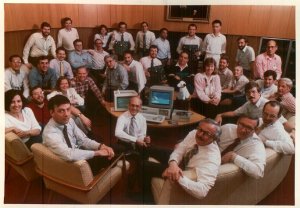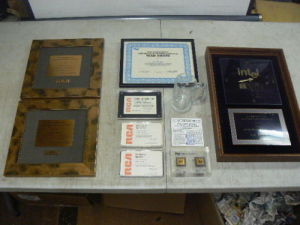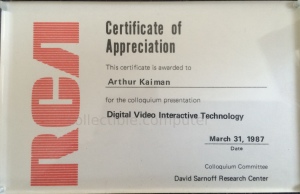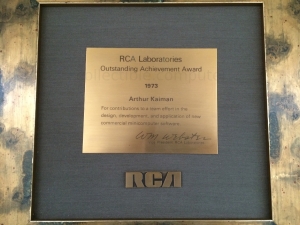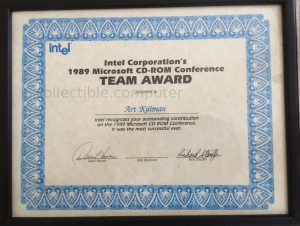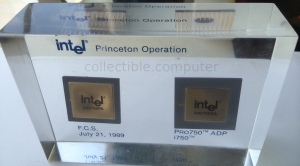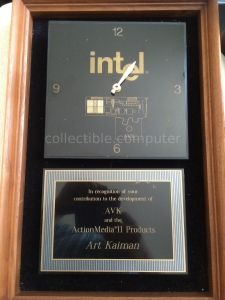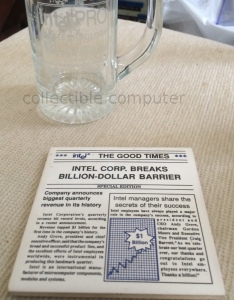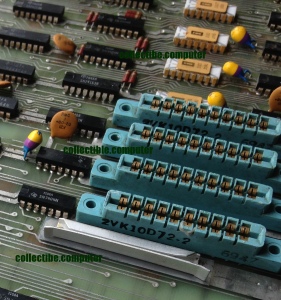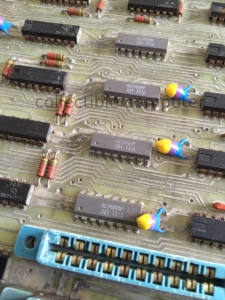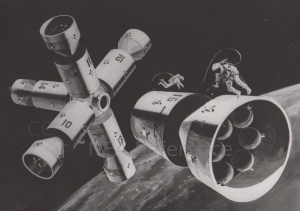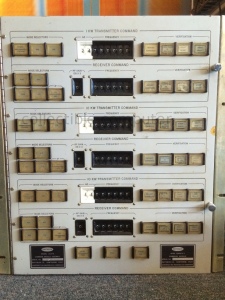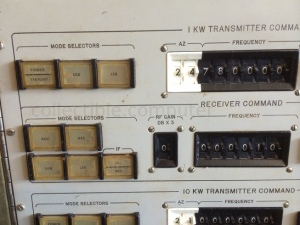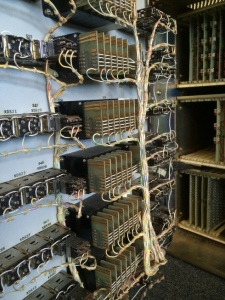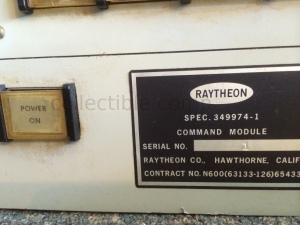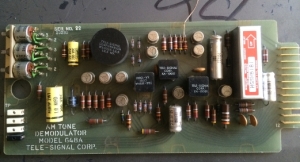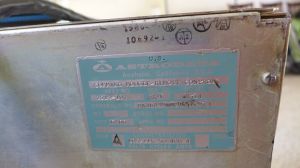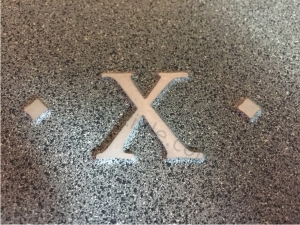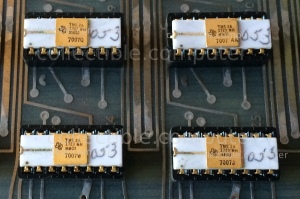Microsoft in March, 1987 was very much a work in progress creating a multimedia strategy. Bill Gates joined in a standing ovation for Art Kaiman and a team from RCA as they demonstrated the first video standard for PC called Digital Video Interactive at a second annual CD-ROM conference. The team's demo was on a "full height" CD-ROM, using a 6-MHz Intel 286, IBM AT running MS-DOS.
According to John Dvorak, Gates was annoyed by being frozen out of the release date of the first CDi products. Kaiman told the press, rather diplomatically, "I can't say this is a CDi killer." Eventually, the product Intel called Actionmedia went on to win Best of Show at Comdex 1991 on both Windows and OS/2.
In the 1940's RCA introduced the famous RCA jack as a way of connecting a phonograph to their radios. In 1942 RCA opened what was to become the RCA Sarnoff Labs named after company and NBC founder David Sarnoff - inventor of color TV, VCR and even the first CMOS CPU, COSMAC for the U.S. Space program. Kaiman was Director of Digital Products for the lab.
Kaiman (closest to bottom) before Intel bought DVI and moved the team to the new Princeton Operation.
Art Kaiman's contribution lives on in the MMX instruction sets on billions of IA-32 compatible CPU's unofficially named for MultiMedia eXtension, Multiple Math eXtension, or Matrix Math eXtension.
- Mr. Kaiman's diplomas: Rutgers - The State University Newark College of Arts & Sciences, BA, 1963 and Stevens Institute of Technology, Master of Sciences (Mathematics), 1966
- There are 10 artifacts in this collection: All were acquired as a group from Kaiman's estate.
- RCA Laboratories Outstanding Achievement Award, 1973, Arthur Kaiman, For contributions to a team effort in the design, development, and application of new commercial minicomputer software, signed Wm Webster, VP, RCA Laboratories. Plate and RCA badge mounted in a mottled brass frame, 11-5/8" x 11-1/8", custom framed by A Gallery, Salt Lake City, Utah, good condition but the plate is slightly crooked
- RCA Laboratories Outstanding Achievement Award, 1974, Arthur Kaiman, For contributions to a team effort in the development of a multiprocessor software system for television broadcast automation, signed Wm Webster, VP, RCA Laboratories. Plate and RCA badge mounted in a mottled brass frame, 11-5/8" x 11-1/8", custom framed by A Gallery, Salt Lake City, Utah, good condition
- RCA Technology Symposium, This certificate is awarded to Arthur Kaiman for planning, organizing and conducting the Computers in Mfg. Symposium. Signed Wm. J. Underwood, Director, Engineering Professional Programs and H.K. Jenny, Manager, Engineering Information. Acrylic plaque with black background, 6" x 4-1/2", good condition with light scratches.
- RCA Certificate of Appreciation, This certificate is awarded to Arthur Kaiman for the colloquium presentation Manufacturing and Productivity - Do It Right the First Time !!, May 11, 1982, Colloquium Committee, David Sarnoff Research Center. Acrylic plaque with black background, 5-1/2" x 3-1/2", good condition with light scratches.
- Ceramic Coaster: Printed on front is a mock newspaper article with the headline: Intel Corp. Breaks Billion Dollar Barrier (this coaster is in the Computer History Museum - View). Intel's revenue first passed $1 billion in 1983. 4-1/4" square with cork backing, good condition.
- RCA Certificate of Appreciation, This certificate is awarded to Arthur Kaiman for the colloquium presentation Digital Video Interactive Technology, March 31, 1987, Colloquium Committee, David Sarnoff Research Center. Acrylic plaque with black background, 5-1/2" x 3-1/2", good condition with light scratches.
- Intel Corporation's 1989 Microsoft CD-ROM Conference Team Award presented to Art Kaiman. Intel recognizes your outstanding contribution on the 1989 Microsoft Conference. It was the most successful ever. Signed Dave House, Bob Brannon, and Rick Stauffer. Framed certificate, 11-5/8" x 9-1/8" overall, good condition.
- Intel Princeton Operation, Intel A82750PA and Intel A82750DA, PRO 750 ADP i750 F.C.S., July 21, 1989. 2 computer chips suspended in an acrylic block, 5" x 3-1/2" x 1-3/8", light scratches and the left chip is slightly crooked in the block. This item is pictured in Manifest Technology's DVI Technology Products Intel PRO750 Product Family (1989) online page (view). This item commemorates the first customer shipment of this product.
- Intel PRO DVI Technology, Happy Holidays, 1990. Clear glass mug, etched, 5-3/4" high, good condition.
- Intel AVK, In recognition of your contribution to the development of AVK and the ActionMedia II Products, Art Kaiman. Clock, black finished brass face with etched to brass numerals, logo, and pictorial representation of the product; separate black finished brass plaque with silver decoration, etched to brass; black felt background, deep brown wood frame, 12" x 18" x 2", missing the minute hand and cap, it also needs cleaning, good otherwise. This clock commemorates the introduction of AVK and ActionMedia II as part of the DVI project between about 1990 and 1992. CLICK HERE to see details.
- DVI team image from Manifest Technology.
In the same month as the DVI Demo for Gates, Kaiman gets an award for DVI merit.
Stamped signature of Dr. William Webster. Webster joined RCA in 1946 after getting a degree from Union College, next door to the G.E. Homestead in Schenectady, N.Y. He went on to be a thorn in his neighbor's side holding patents in television, vacuum tubes, gas tubes, circuitry, and semiconductor devices.
Personally Signed by Mr. "Intel Inside" Dave House. Rick Stauffer, marketing manager at PRO, was loosing the standards battle to Quicktime and MPEG by 1992.
First i750 chip-sets "W #12". These packages look empty but the MMX they inspired packs a lasting punch.
Time ticks down for Actionmedia II ostensibly because of high costs for both consuming and producing DVI video .
Intel SWAG!
In 1993 the Intel Princeton Operation (PRO) was finally closed relocating some but ending the role of Art Kaiman . Although DVI was ultimately not successful it paved the way for other formats like AVI that have made the PC a multimedia powerhouse.
Collector's Insight
IBM PS/2 Ultimedia Model 57 SLC and 77s are based on DVI technology. These originally included the $2K Actionmedia II board. They can be identified by front audio jacks and an early PS/2 CD-ROM drive. Also look for DVI and Ultimedia logos.
